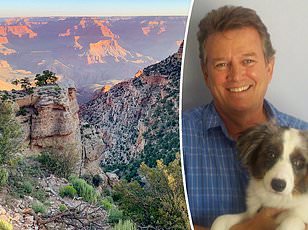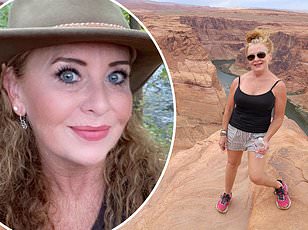America's deadliest canyon revealed - with top tourist site averaging around 12 fatalities every year
The breathtaking Grand Canyon is one of America's top tourist attractions, welcoming close to five million visitors every year.
But the natural wonder is also considered to be the most dangerous National Park in the country by far, averaging around 12 fatalities each year - with roughly 200 deaths since 2007.
Given its popularity these figures may not come as a complete surprise, but the wide-ranging causes of death could prove startling.
From falls and mistakes like drinking too much water to aircraft crashes and even murder - the Arizona attraction holds more dangers than you might think.

The Grand Canyon is breathtaking - but it's also where hundreds have literally taken their last breaths

The natural wonder is the most dangerous National Park by far, and averages around 12 fatalities each year. Causes of death range from falls to murder

The canyon also has had roughly 200 deaths since 2007
Aviation accidents
Spanning some 270 miles and reaching up to 18 miles wide, much of the Grand Canyon's deadliness stems from its towering rock formations.
Dying by plane or helicopter crash thus remains the most common cause of death at the canyon, with several pilots colliding with cliff faces.
There was even a mid-air collision over the canyon in 1956, when a United Airlines plane hit one from Trans World Airlines. All 128 people onboard instantly perished.
Even excluding the lethal collision, aircraft crashes still remain the most common cause of Grand Canyon deaths.

A rendering of the 1956 collision - the first in aviation history to cause more than 100 casualties

The severed tail assembly of the TWA Constellation, as photographed by park rangers during their investigation

A passenger's coat is seen lying on the rim of the canyon in the wake of the crash, which to this day, remains the deadliest incident to occur in the National Park

An Army helicopter is seen hovering around the site of one of the crashed commercial planes

The circled wreckage on the side of Chuar Butte was all that remained of United Airline's DC7

This image again shows the two main impact sites. The United DC-7's wreckage is seen to the northeast of the remains of the TWA Super Constellation
A total of 251 other people have died in dozens of smaller crashes before and since, with the statistic being tracked since the early 1900s up until 2017.
The Grand Canyon was officially established as a National Park in 1919, meaning the data represents deaths from roughly the past 100 years.
Another midair collision in 1986 - 30 years after the first - again added to the death toll by 25.
The fiery crash occurred when a chartered helicopter and a twin-engine sightseeing plane collided within the canyon's characteristic cliffs, sending both plummeting onto a remote plateau below.
Aside from causing casualties, the crash called into question the safety of the canyon's then-booming air-tour business - a $50 million industry.
The crash also occurred in perfect weather, with clear visibility - leading the National Transportation Safety Board to deem that an overlapping series of long-running disputes over airspace rules were to blame.
Operational concerns, environmental impacts, and regulatory authority added to the confusion, while creating competing interests among the various companies and federal agencies operating within the National Park.
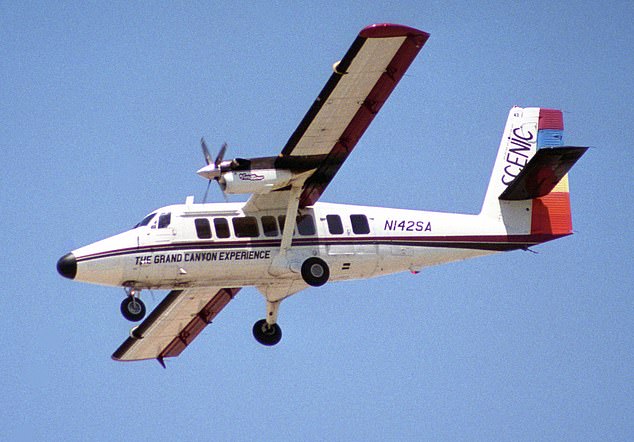
Another midair collision in 1986 - 30 years after the first - again claimed several lives, this time 25
These forces were all at work when an ill-fated decision was made to deviate the usual route of the helicopter, causing it to cross paths with the commercial airplane from Grand Canyon Airlines.
The result was a catastrophe for the books - one that led to an overhaul of the way flights are conducted there, drastically reducing rates of death.
The natural environment adds an element of danger as well, as the canyon's inherent size and rugged cliff faces continue to claim lives to this day.
In February 2018, a sightseeing helicopter crashed into one such cliff face and burst into flames in the canyon, killing five.
Jonathan and Ellie Milward Udall, 29, boarded the helicopter from Boulder City, Nevada, with veterinary receptionist Becky Dobson, 27; her boyfriend and car salesman Stuart Hill, 30; and Hill’s brother, 32-year-old lawyer Jason Hill.
They were touring the canyon on the Hualapai reservation, outside the boundaries of the national park, when the crash happened.

Stuart Hill, 30, his girlfriend Becky Dobson, 27, who both died in a helicopter crash while touring the canyon in 2018

Ellie Milward Udall, 29, and her husband Jonathan Udall, 32, were airlifted to hospital with serious injuries, and also died

Hill’s brother, 32-year-old lawyer Jason Hill, died with his brother and girlfriend upon impact
The Udalls initially survived, but later died of complications from burn injuries.
Jonathan's parents sued the tour company and the helicopter's manufacturer, which both ponied up a combined $100 million for a cash settlement
The suit had claimed their son could have survived, and blamed his death on the lack of a crash-resistant fuel system that's since been made mandatory.
The Airbus EC130 B4 crashed just before sunset in a section of the Grand Canyon where air tours aren’t as highly regulated.
All were on the trip to celebrate Stuart's birthday, and all hailed from England.
The National Transportation Safety Board said turbulent winds were a probable cause of the loss of control and tail-rotor effectiveness before the hard landing, which caused the fuel to ignite.
The deadliest time in the canyon, however, was during the '80s, statistics show - but since then, as air-related deaths diminished, deaths stemming from environmental factors like heat have been on the rise.

The Airbus EC130 B4 crashed just before sunset in in a section of the Grand Canyon where air tours aren’t as highly regulated
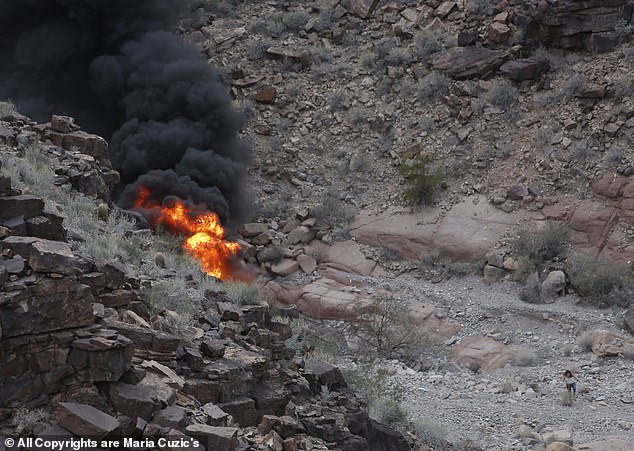
The National Transportation Safety Board said turbulent winds were a probable cause of the loss of control and tail-rotor effectiveness before the hard landing, which caused the chopper's fuel to ignite
Falls
The second-most common cause of death within the canyon today does not stem from the elements, but rather falls from its high ledges.
Whether with an accidental fall - 123 since the park opened - or someone leaping to their death on purpose, the cliffs of the Grand Canyon continue to claim lives at a startling rate.
Some 75 have used died by suicide, putting the total number of fall fatalities at just under 200.
Many of the falls were accidents that could have easily been avoided, like 19-year-old Jonathan Fielding who plummeted approximately 300 feet and died on impact, near Moonscape Overlook in February.

That wasn't the case for 19-year-old Jonathan Fielding (seen here) this past February, when he fell approximately 300 feet and died on impact, near Moonscape Overlook

The teen had gotten too close to a ledge and fell, as he took photos during a hike at the overlook (seen here)

Officers afterward said they believed Fielding had been attempting to get a better shot when he lost his footing. His death, like so many others before, was ruled accidental
The teen had stepped too close to a ledge and fell while visiting with two friends, as the trio took photos during a hike at a popular overlook.
Officers afterward said they believed Fielding had been attempting to get a better shot when he lost his footing. His death was ruled accidental.
Meanwhile, the death of a 33-year-old man in June 2023 at the famed the Grand Canyon Skywalk was ruled a suicide - a death not included in the 75, which only goes up to 2017.
A further 16 have killed themselves using other methods at the canyon.
Hiking- and environment-related deaths
Environment-related deaths are the next most common cause of death, with reasons ranging from dehydration to drinking too much water.
Just last month, a 69-year-old man died after being found semi-conscious on a popular hiking trail called River Trail, which runs for just under two miles along the Colorado River.
Officials identified the hiker as Scott Sims from Austin, Texas, explaining in a subsequent press release how he had been heading to Phantom Ranch where he was planning on staying for the night.
Three National Park Service paramedics rushed to the hiker's position from Phantom Ranch as bystanders began doing CPR on Sims on on June 29, but all efforts to resuscitate him were unsuccessful.

Scott Sims, 69, from Austin, Texas, was hiking in the Grand Canyon when he died on June 29. He was one of three hikers to die from dehydration within a matter of weeks
This led the Park Service to issue a dire warning about extreme heat while hiking, especially on trails like the one Sims had been on.
His death was not even the latest life claimed by the canyon's notorious summer heat, and came a week before park rangers received a call about another unresponsive hiker on the Bright Angel Trail, about 100 feet below the Bright Angel Trailhead.
Bystanders administered CPR as medical personnel responded from the rim, but all attempts to resuscitate the man were unsuccessful, and he died.
He was later revealed to be a 50-year-old also from Texas, who had been trying to reach the rim for an overnight stay at Havasupai Gardens. He was only 100 feet away.
Both of these deaths occurred days after an unresponsive hiker was found on the Bright Angel Trail, about half a mile east of the Pipe Creek River Resthouse.
The 41-year-old man was hiking out of the canyon after an overnight stay at the Bright Angel Campground near Phantom Ranch.
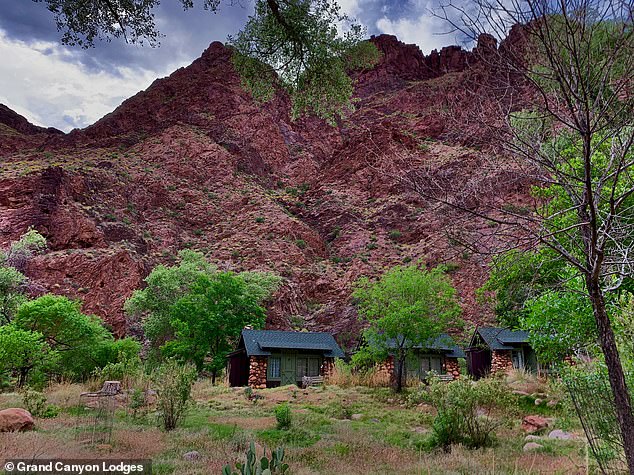
Both of their deaths occurred days after an unresponsive hiker was found on the Bright Angel Trail, about half a mile east of the Pipe Creek River Resthouse. He had been a 41-year-old hiking out of the canyon after a stay at Bright Angel Campground near Phantom Ranch (seen here)
Again, he almost made it, but as so many before him, likely underestimated the difficulty that comes with exiting the canyon. It's a great deal more strenuous than entering, experts have pointed out - especially during summer months.
At this time of year, temperatures regularly reach 120 degrees at bottom of the canyon - though it often feels more like 130 to 140 due to rocks absorbing radiation from the sun and creating a stifling effect.
Other natural deaths include freezing, cardiac arrest and being struck by lighting - one of the less likely causes of death.
One of the strangest, though, is from drinking too much water - an occurrence that is also exceedingly rare.
In 2008, a British woman became the first Grand Canyon hiker to die by 'water intoxication,' doctors said - explaining how the unnamed woman had consumed so much water so quickly, the levels of salt in her blood plummeted.
This caused the Londoner's brain to swell during a 6.2-mile hike across the National Park with her husband in September of that year, ultimately claiming her life.
Drowning
The next most-common death is drowning, with roughly 100 or so travelers losing their lives in the raging Colorado River over the years.
In 2021, Rebecca Copeland, 29, of Ann Arbor, Michigan, was found dead in frigid water after a flash flood swept through her commercial rafting group's overnight campsite.
The camp was set at an established site about a quarter of a mile from the slot canyon, National Park Service spokeswoman Kaitlyn Thomas said, before revealing that it was a different commercial group that found Copeland as well as an uninjured second person also swept up by the swell.
Five others were injured in total, she said - one critically.
Park rangers advise visitors to be wary of the river at all times.

In 2021, Rebecca Copeland, 29, of Ann Arbor, Michigan, was found dead in frigid water after a flash flood swept through her commercial rafting group's overnight campsite.

Another 100 or so souls have also lost their lives in the raging Colorado River over the years.

Whether it be rafters, swimmers, or people just trying to cross the famous tributary, all perished after perhaps underestimating its perils
Murders and suicide
Since 1919, the park has recorded at least 39 murders, as well as 90 suicides.
The latter includes the 75 who leapt off one of the canyon's countless cliffs, as well as at least 15 others who killed themselves in other ways.
Neither were the case for 34-year-old Tomomi Hanamure, a Japanese tourist who turned up dead in the waters below a waterfall at an Indian reservation that lies partly within the Canyon.
She had not drowned, officials found - revealing she had been instead stabbed 29 times. She had been traveling alone, and was reported missing on May 9, 2006.

In 2006, 34-year-old Tomomi Hanamure, a Japanese tourist, turned up dead in the waters below a waterfall at an Indian reservation that lies partly within the Canyon. She had not drowned, officials found - revealing she had been instead stabbed 29 times, cops found

Meanwhile, he death of a 33-year-old man in June of last year at the famed the Grand Canyon Skywalk (seen here) was ruled a suicide - a death not included in the 75
Her body was found by swimmers four days later, spurring an investigation that culminated with a life sentence for a then-18-year-old Randy Redtail Wescogame, after he owned up to the crime.
A member of the local Havasupai tribe with a history of theft and meth addiction, he put a knife up to the woman's neck before robbing and murdering her.
Many people have gone missing in the canyon since and are suspected to be victims of murder, but the incident involving Hanamure serves as the most recent example.
That said, homicides at such a well-visited spot remain decidedly uncommon, with most of the 38 other killings occurring more than 50 years ago.



























